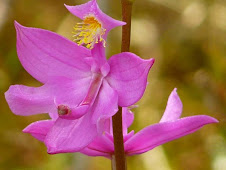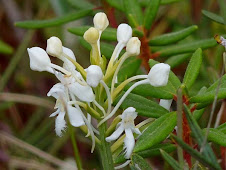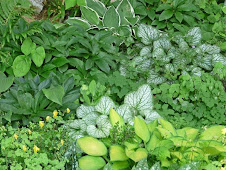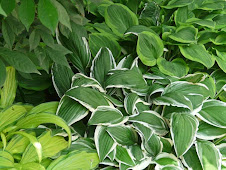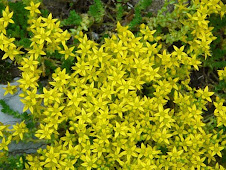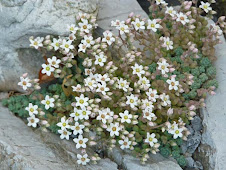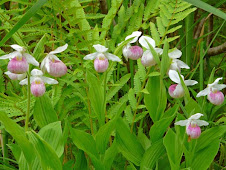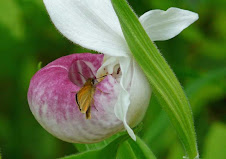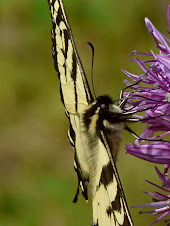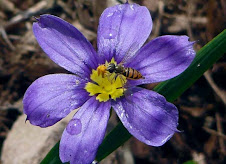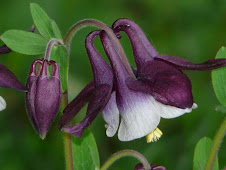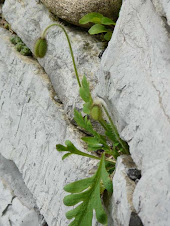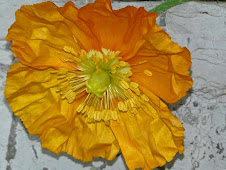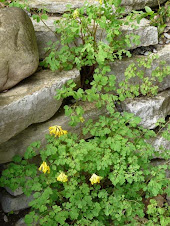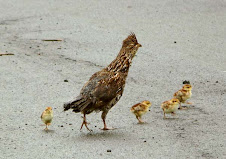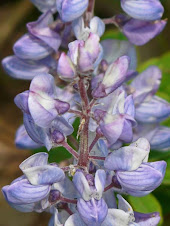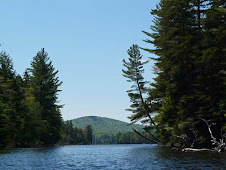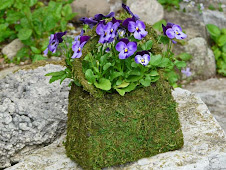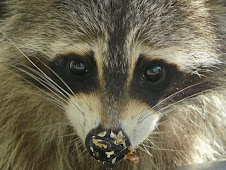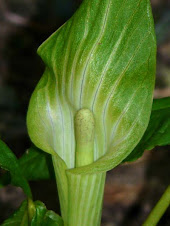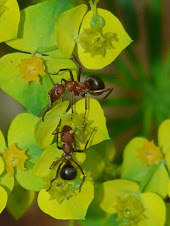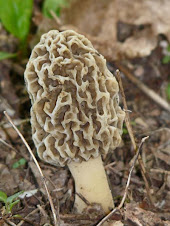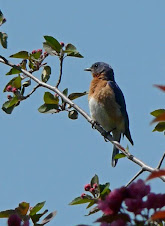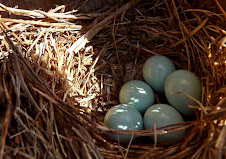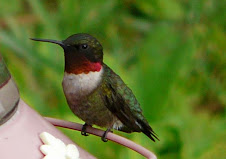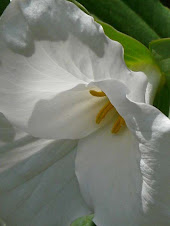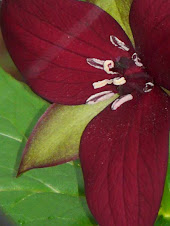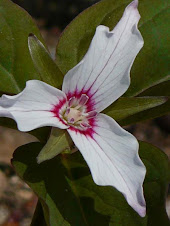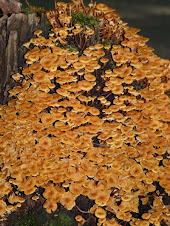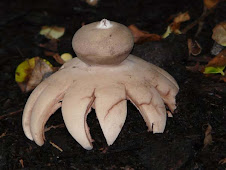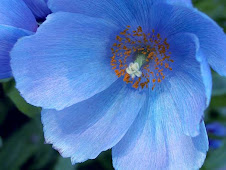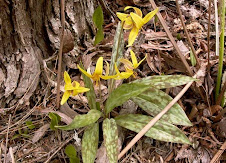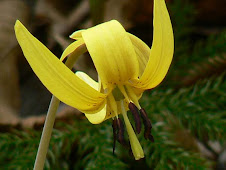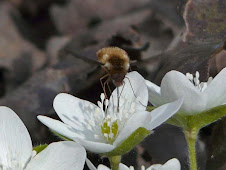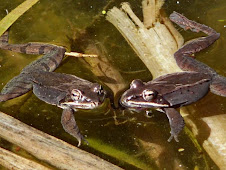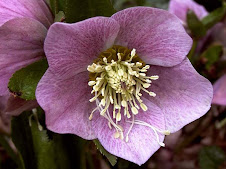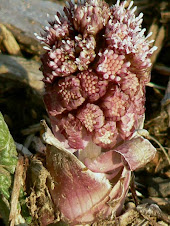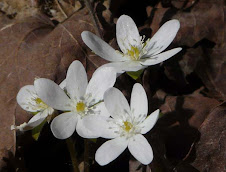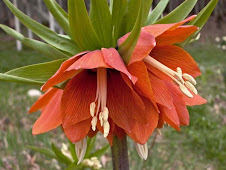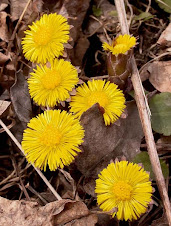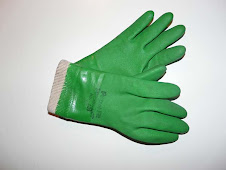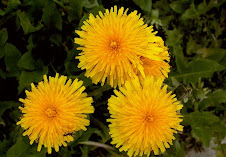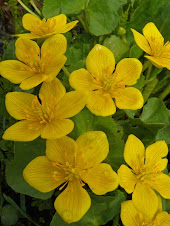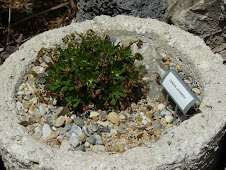...too quickly. Summer that is, and I think I said that same thing about Spring. But, at least my days are very full of wonderful adventures and visits from family and friends.
I have stolen a few quiet moments for myself, to photograph more of New York State's many Orchids. On Sunday my husband and I drove to Ferd's Bog in the Adirondack Mountains. It is an amazing quaking bog, with a board walk that actually floats on the bog. This keeps people from trampling the flora. Sundew, Pitcher Plant, Bog Herbs and many Grasses can be found Spring through Autumn. The walk into the bog is about 3/10th of a mile through a woods filled with Ferns, Mosses, Lichens, Fungus and many Wildflowers.
I try to go there several times each season, as there are always many wonderful surprises awaiting this avid photographer. On Sunday Calopogon pulchella (Grass-Pink) and Habenaria blepharigottis (White Fringed Orchis) were both blooming.
Our Grandchildren have been visiting with us for the past 5 days and its been a busy time, playing with them. But, alas somebody's has to do it. Certainly glad that it has been me....
Monday, July 13, 2009
Wednesday, July 1, 2009
The deer that sleep...
...in our meadow, that forage on our lawn, that bring new born fawns to frolic in our meadow, are welcome, now. Now, that they sleep, eat and play within our yard and not in our gardens, especially the eat part. The Repels All Spray and Granules that I have been using since March are really working and thus the deer are now really beloved. So far the Repels All is also keeping the ground hog, and various bugs from devouring our plants too.
I began my new position on Staff at a local Outdoor Educational Center and now I'm trying to maintain balance in my life. I've been "Retired" for several years and now I'm re-learning that juggling act of keeping all parts of my life in sync.
I want to share some of the garden, through my photos. It is such a joy to see Hostas, Sedum and other plants that are growing, thriving and lovely. I am not including names, common or botanical, because I don't want to look through my files for correct identification tonight. But, will upon request.
Next blog I want to share a magnificent new gardening tool, which I just purchased. I weeded 3 large and 1 small gardens today within an hour, using this incredible tool. Talk soon.
I began my new position on Staff at a local Outdoor Educational Center and now I'm trying to maintain balance in my life. I've been "Retired" for several years and now I'm re-learning that juggling act of keeping all parts of my life in sync.
I want to share some of the garden, through my photos. It is such a joy to see Hostas, Sedum and other plants that are growing, thriving and lovely. I am not including names, common or botanical, because I don't want to look through my files for correct identification tonight. But, will upon request.
Next blog I want to share a magnificent new gardening tool, which I just purchased. I weeded 3 large and 1 small gardens today within an hour, using this incredible tool. Talk soon.
Thursday, June 25, 2009
The amazing Ladies of the Bog...
...are back, and as lovely as always. The ladies are Cypripedium reginae, Showy Lady's Slipper Orchids. They are the largest and most beautiful of the wild orchids of New York State.
When I first moved to the Adirondack area, several new friends asked if I had ever photographed the Showy Lady's Slipper. I had not and asked where I might find them. Several friends showed me areas, where they might be found. And a few more friends helped me search for them. It was well into June and we had not found them. I was extremely disappointed and for a while thought they might not really exist, they might be like the elusive Snipe.
The Friday before Father's Day, quite discouraged, I stopped at our Post Office. The Postal Clerk asked why I was so glum. To the answer, she smiled and said, there are hundreds on our property. She gave me directions and permission to photograph to my heart's content. Which I did then, and continue to so every year, along with about 200 or 300 hundred other happy photographers from all over New York State.
When I first moved to the Adirondack area, several new friends asked if I had ever photographed the Showy Lady's Slipper. I had not and asked where I might find them. Several friends showed me areas, where they might be found. And a few more friends helped me search for them. It was well into June and we had not found them. I was extremely disappointed and for a while thought they might not really exist, they might be like the elusive Snipe.
The Friday before Father's Day, quite discouraged, I stopped at our Post Office. The Postal Clerk asked why I was so glum. To the answer, she smiled and said, there are hundreds on our property. She gave me directions and permission to photograph to my heart's content. Which I did then, and continue to so every year, along with about 200 or 300 hundred other happy photographers from all over New York State.
Sunday, June 21, 2009
What a difference a day...
...makes, and what difference a week makes. I "retired" a few years ago, but volunteer at an Art Museum, as a docent, doing tours for elementary school children. My business as a Nature Photographer keeps me fairly busy, and I am a member of an Artist Co-op in Old Forge, New York. As a member we share time working at the shop. However, this past week was very serendipitous, and one exciting event after another kept occurring.
I learned about and became a staff member of a fairly new Nature Center, and will possibly be doing some field guides, using my photos. The Nature Center does tours for elementary school children. Hiking, Mountain Biking, Cross Country Skiing and Snow Shoeing are just a few of the exciting things offered at the Center.
Life is good... and exciting and fun and I am very, very grateful.
I learned about and became a staff member of a fairly new Nature Center, and will possibly be doing some field guides, using my photos. The Nature Center does tours for elementary school children. Hiking, Mountain Biking, Cross Country Skiing and Snow Shoeing are just a few of the exciting things offered at the Center.
Life is good... and exciting and fun and I am very, very grateful.
Thursday, June 11, 2009
Long awaited Spring...
...is almost a memory. In just ten days it will be Summer. Here in the North Country, The Adirondacks of New York State, it looks like the song from Carousel, "June Is Bustin' Out All Over". It is very lush and green and leaves are on all the trees. The Ginkgo was a little late in leafing out but, it is quite lovely now. My Poppies are poppin' and the Iris are bloomin' and every plant is growing tall, full and vigorous. I am so blessed that this year the gardens are full of so many plants. The deer are avoiding the gardens and so far, so is the ground hog. I saw the ground hog yesterday. When our Grandson and Nephew come up for a visit, I will have them help me try to fill the hole that is nearest the house. I guess I better do some research and see what works best, to relocate its home enterance. Any comments would be appreciated. The Repel's All Spray seem to be detering them for now.
Eastern Tiger Swallowtail butterflies are in and around the gardens, as are some species of bees. I have been seeing many species of spiders also. The Pointed Blue Eyed grass is blooming and attracting many bees, as you can see in the photo.
I have been on several day trips with my docent friends this past week. I volunteer, as a docent at a local Art Museum. I am including a self portrait, taken on our trip yesterday to the Albright-Knox Museum in Buffalo, New York. It was a wonderful bus trip to see an Exhibit of Abstract Artists which included Pollack, DeKooning, Still, Krassner, Motherwell and many more.
Eastern Tiger Swallowtail butterflies are in and around the gardens, as are some species of bees. I have been seeing many species of spiders also. The Pointed Blue Eyed grass is blooming and attracting many bees, as you can see in the photo.
I have been on several day trips with my docent friends this past week. I volunteer, as a docent at a local Art Museum. I am including a self portrait, taken on our trip yesterday to the Albright-Knox Museum in Buffalo, New York. It was a wonderful bus trip to see an Exhibit of Abstract Artists which included Pollack, DeKooning, Still, Krassner, Motherwell and many more.
Friday, June 5, 2009
I began blogging...
... because I wanted to share with other gardeners, the trials and tribulations of gardening, and dealing with the "deerbeloved". I do love the deer and try to live peacefully with them. It is much easier now that I have finally found a solution to the problem, of the deer eating everything that I plant. I don't even consider vegetable gardens, because in addition to the Deer we reside with Rabbits, Ground Hogs, Skunks, Fox, Weasel, Squirrels (red, gray & black), Chipmonks, Opossum, Bear, Coyotes, Turkey and Porcupine. I love growing prennial plants, and to avoid needless disappointment, I try to plant, plants that most animals find unappetizing. For example Foxglove, Monkshood, Bear's Breeches, Alliums, and Herbs. Things that are poisonous, fuzzy, gray-green or prickly, are usually unappetizing. In addition to plant choices, I also use an amazing spray and granules called Repel's All. These things are working!!!! Last year I actually enjoyed Hosta and Day Lilies throughout their entire growing season.
I began animal proofing the gardens early this year. In March before the snow was gone from the gardens, I applied Repel's All granules to each garden. In April when spouts appeared, I sprayed them with Repel's All spray. As each plant grew, I reapplied spray to the new growth.
And....it is working even better than last year. Plants that I planted many years ago, that spouted and started growing but, were eaten before blooming...are now BLOOMING!!!
Plants that I almost forgot about...are now BLOOMING!!! There are 9 different species of Aquilegia, (Columbines) growing and blooming in the woodland shade garden. And many more plants that were also digested, before any enjoyment from this gardener.
I am so grateful to be able to live peacefully with the local fauna and truly enjoy the beauty of each prennial garden.
I began animal proofing the gardens early this year. In March before the snow was gone from the gardens, I applied Repel's All granules to each garden. In April when spouts appeared, I sprayed them with Repel's All spray. As each plant grew, I reapplied spray to the new growth.
And....it is working even better than last year. Plants that I planted many years ago, that spouted and started growing but, were eaten before blooming...are now BLOOMING!!!
Plants that I almost forgot about...are now BLOOMING!!! There are 9 different species of Aquilegia, (Columbines) growing and blooming in the woodland shade garden. And many more plants that were also digested, before any enjoyment from this gardener.
I am so grateful to be able to live peacefully with the local fauna and truly enjoy the beauty of each prennial garden.
Monday, June 1, 2009
A few of the best plants...
that I never planted. The rock garden is above a wonderful rock wall which is now a garden itself. Within the nooks and crannies of the wall, many sedums and alpine plants now reside.
When we were in Italy, last May, we visited several fortified medieval cities, among them San Marino and Assisi. Those walls contained wonderful alpine plants, which I found fascinating.
Two of the many plants that are now residing within my garden walls are Papaver alpinum, Alpine Poppy and Corydalis lutea. (sorry but I don't know the common name of the Corydalis) The "parent plant" of the Corydalis is in the rock garden above the wall, and has provided seed for a least 6 of the "wall plants". The "parent plant" of the Poppy is gone now but its seed produced the wonderful specimen now growing within the wall. Sometimes the most delightful plants are those that plant themselves.
When we were in Italy, last May, we visited several fortified medieval cities, among them San Marino and Assisi. Those walls contained wonderful alpine plants, which I found fascinating.
Two of the many plants that are now residing within my garden walls are Papaver alpinum, Alpine Poppy and Corydalis lutea. (sorry but I don't know the common name of the Corydalis) The "parent plant" of the Corydalis is in the rock garden above the wall, and has provided seed for a least 6 of the "wall plants". The "parent plant" of the Poppy is gone now but its seed produced the wonderful specimen now growing within the wall. Sometimes the most delightful plants are those that plant themselves.
Thursday, May 28, 2009
Many new arrivals...
...create lots of photo opportunities. Today was a "play day" shared with my friend Diane. We left home early to allow us lots of time for exploring. Our destination was Cooperstown, New York and a visit to the Fenimore Art Museum, which is where James Fenimore Cooper, the novelist grew up. The collection is an outstanding one which includes paintings by Thomas Cole, Gilbert Stuart, Benjamin West, Eastman Johnson, Grandma Moses and many other American Artists. It is always a favorite "play day" adventure. Lunch on the shore of Otesego Lake at the Blue Mingo, was as usual, a gourmet delight. We both enjoyed a Salmon and Corn Chowder, followed by Lobster Salad Sandwich and dessert of Key Lime Custard.
After driving only a short distance, we noticed a family of Canada Geese on the banks of the West Canada Creek, which included a Male, a Female and nine Goslings. Then we stopped by a favorite water fall, on the Little Black River. The rain the day before, made the falls even more spectacular. Another family of fowl was spotted at the falls, a Female Ruffed Grouse and four chicks.
One adventure after another completed a magnificent "play day" of flora, fauna and fun.
After driving only a short distance, we noticed a family of Canada Geese on the banks of the West Canada Creek, which included a Male, a Female and nine Goslings. Then we stopped by a favorite water fall, on the Little Black River. The rain the day before, made the falls even more spectacular. Another family of fowl was spotted at the falls, a Female Ruffed Grouse and four chicks.
One adventure after another completed a magnificent "play day" of flora, fauna and fun.
Tuesday, May 26, 2009
Memorial weekend flew...
...by so quickly. Lots of work, lots of play and tender, yet sad memories.
We lost a courageous young soldier, who was a member of our parish, a few weeks ago. Blaise lost his life in Iran, fighting for ideals which he strongly believed in, and will greatly missed by all members of our community.
It was also a weekend to remember those community members and family members who fought and died or fought and lived, for freedoms we all enjoy.
It was a weekend to go to "The Sand Plains in Rome, New York" to photograph the wild blue Lupine. The sand plains are, one of a few inland Pine barrens, left in the Northeast. The threatened frosted elfin butterfly which feeds on the Lupine can also be found there.
We also had time to go kayaking in the Mountains, another one of my passions. My husband and I have been kayaking for many years. We each have an Old Town Loon kayak. My husband's kayak is 17'5" and weighs about 60 pounds. Mine is 11' 1" and weighs about 35 pounds. The one thing we enjoy most about kayaking is we play on the same team but, different positions. My husband enjoys exploring while kayaking and I prefer to photograph and spend lots of time in one area. However, we always start and end our journey together.
We lost a courageous young soldier, who was a member of our parish, a few weeks ago. Blaise lost his life in Iran, fighting for ideals which he strongly believed in, and will greatly missed by all members of our community.
It was also a weekend to remember those community members and family members who fought and died or fought and lived, for freedoms we all enjoy.
It was a weekend to go to "The Sand Plains in Rome, New York" to photograph the wild blue Lupine. The sand plains are, one of a few inland Pine barrens, left in the Northeast. The threatened frosted elfin butterfly which feeds on the Lupine can also be found there.
We also had time to go kayaking in the Mountains, another one of my passions. My husband and I have been kayaking for many years. We each have an Old Town Loon kayak. My husband's kayak is 17'5" and weighs about 60 pounds. Mine is 11' 1" and weighs about 35 pounds. The one thing we enjoy most about kayaking is we play on the same team but, different positions. My husband enjoys exploring while kayaking and I prefer to photograph and spend lots of time in one area. However, we always start and end our journey together.
Wednesday, May 20, 2009
Ring around the rosies...
...a pocket full of posies. I have always loved that poem, and the little dance that we did, as we sang it. Last week a friend gave me a very special gift, a real pocket full of posies. She purchased the "pocketbook" which is covered with moss, and added the posies. The sweet little bluish purple pansies couldn't be prettier.
The gardens are becoming very lush. The rains and now warmer weather has everything growing, almost before my eyes. Fortunately this year I have been able to keep up with the weeding. I even started a compost bin. In the past I didn't bother doing one for fear the bears and other critters would just disturb it, but so far they haven't. In addition to clippings, weeds and pruned items I have also added fruit peels, coffee grounds, and veggies leftovers. However, it will probably be several years before good compost is available.
Happy gardening...
The gardens are becoming very lush. The rains and now warmer weather has everything growing, almost before my eyes. Fortunately this year I have been able to keep up with the weeding. I even started a compost bin. In the past I didn't bother doing one for fear the bears and other critters would just disturb it, but so far they haven't. In addition to clippings, weeds and pruned items I have also added fruit peels, coffee grounds, and veggies leftovers. However, it will probably be several years before good compost is available.
Happy gardening...
Tuesday, May 19, 2009
If you don't like the weather...
...just wait a few hours. Last night the temperatures hovered around 20 degrees. Yes, we got a frost. Knowing that this was a probable, I covered the four zone 7, ornamental grasses that I dared to plant early. They are really annuals for this area, as we are in zone 4. In the fall I plan to remove them from the garden and winter them over in the house. They are worth the trouble, as they are really lovely. Two are Cymbopogon citratus, Lemon Grass and two are Pennisetum setaceum 'Fireworks'. They are not very special to look at now, the Lemon Grass is just a wide blade yellow green grass, but in the late summer and early autumn it will obtain greater height and hues of red, orange and gold. Fireworks true to her name will blast into reds, deep greens and golds. Photos will be more impressive later in the season. And true to form the weather changed and it was in the 70's today. We had an early evening visitor last night. I remove the suet, seed feeders and peanuts every night because I don't want to attract nocturnal visitors. Bears, raccoon, skunks etc. will seek out free meals that I would rather save for the birds, especially since the latter don't eat like birds.
Sunday, May 17, 2009
Yesterday was a most...
...unusual day. It rained off and on all day. I truly wanted to accomplish some gardening tasks, but each time the rain stopped and I assembled my gardening tools...the rain returned. Finally I decided to just stop trying and do sometime else. Then the sun came out. So, instead of gardening I grabbed my camera and went in search of photo opportunities. It didn't take long to find a few fun and funny things to photograph.
 This little Chickadee seemed to be having a really Bad Hair Day. Actually it had been bathing in a shallow stream of water and was trying to groom itself when I found this photo op.
This little Chickadee seemed to be having a really Bad Hair Day. Actually it had been bathing in a shallow stream of water and was trying to groom itself when I found this photo op.
I continued photographing for about an hour and then returned home. On the balcony I observed a gray squirrel on the "Squirrel Proof Feeder". When I approached him he climbed down and gave me a look that seemed to say...
 ...Why are you looking at me? I didn't do anything, it wasn't me on the Bird Feeder, it must have been someone that resembled me. You can't prove a thing, I"m innocent, you believe me don't you?
...Why are you looking at me? I didn't do anything, it wasn't me on the Bird Feeder, it must have been someone that resembled me. You can't prove a thing, I"m innocent, you believe me don't you?
 This little Chickadee seemed to be having a really Bad Hair Day. Actually it had been bathing in a shallow stream of water and was trying to groom itself when I found this photo op.
This little Chickadee seemed to be having a really Bad Hair Day. Actually it had been bathing in a shallow stream of water and was trying to groom itself when I found this photo op.I continued photographing for about an hour and then returned home. On the balcony I observed a gray squirrel on the "Squirrel Proof Feeder". When I approached him he climbed down and gave me a look that seemed to say...
 ...Why are you looking at me? I didn't do anything, it wasn't me on the Bird Feeder, it must have been someone that resembled me. You can't prove a thing, I"m innocent, you believe me don't you?
...Why are you looking at me? I didn't do anything, it wasn't me on the Bird Feeder, it must have been someone that resembled me. You can't prove a thing, I"m innocent, you believe me don't you?
Friday, May 15, 2009
A Wonderful day of...
...discovering. I have a passion for photography. The last few weeks it seems as soon as my feet hit the floor in the morning, I am off and running. But, today I had most of the day to myself. There is nothing I enjoy more than to just take my camera and go looking for whatever, is waiting to be "discovered" and photographed.
First I "discovered" that the Jacks are back. Both the green and brown. I like to turn up the flaplike spathe and photograph "Jack" the club like spadix.
Next among the Euphorbia esula, Leafy Spurge I found several Red Ants, Formica exsectoides. They are rusty red on the head and thorax and blackish brown on the legs and abdomen. Worker often stay near aphids or transport them to collect their "honeydew". Honeydew is a saplike liquid which the aphids secrete.
Next I found Morel mushrooms in several places, where I have not found them before. They are edible and if I find enough, I will pick them and cook them. A local grocery store sells Morels at $99.00 a pound. They are a very valuable "discovery". The question is do I like photographing them or eating them? Both!!!
First I "discovered" that the Jacks are back. Both the green and brown. I like to turn up the flaplike spathe and photograph "Jack" the club like spadix.
Next among the Euphorbia esula, Leafy Spurge I found several Red Ants, Formica exsectoides. They are rusty red on the head and thorax and blackish brown on the legs and abdomen. Worker often stay near aphids or transport them to collect their "honeydew". Honeydew is a saplike liquid which the aphids secrete.
Next I found Morel mushrooms in several places, where I have not found them before. They are edible and if I find enough, I will pick them and cook them. A local grocery store sells Morels at $99.00 a pound. They are a very valuable "discovery". The question is do I like photographing them or eating them? Both!!!
Wednesday, May 13, 2009
The month of May...
...is my very favorite month. I want to be outside every possible minute. The sounds, sights and smells are all so fresh and wonderful. Baltimore orioles, Scarlet Tanagers, Ruby-Throated Hummingbirds and Warblers have all returned. The meadow and wood are a cacophony of bird melodies. The gardens seem to be growing so quickly that, the growth can be heard. The sweet smells of flowering trees, woodland treasures and gardens fill each breathe I take.
Discovery everywhere...each morning some new leaf or bud...eggs in the nest in the blue bird house...peepers and other frogs, a chorus nightly...insects...bee buzzing in and around each garden, shrub and tree...butterflies, dragonflies, moths.
I recall the words in a song from the Musical Carousel. "April cried and stepped aside and along came pretty little May. May was full of promises but, she didn't keep them quick enough for some". Well, she keeps them quick enough for me. And she always keeps her promises.
Discovery everywhere...each morning some new leaf or bud...eggs in the nest in the blue bird house...peepers and other frogs, a chorus nightly...insects...bee buzzing in and around each garden, shrub and tree...butterflies, dragonflies, moths.
I recall the words in a song from the Musical Carousel. "April cried and stepped aside and along came pretty little May. May was full of promises but, she didn't keep them quick enough for some". Well, she keeps them quick enough for me. And she always keeps her promises.
Sunday, May 10, 2009
I'm back...
...and couldn't believe that so many days had just disappeared, since I last posted. The gardens have been taking up a lot of time. I don't do as much work in the Autumn putting them to bed, because I generally leave as much as possible, seed etc. for the birds and small mammals to feed on. But, that means a lot of clean up in the Spring. I also leave a lot of leaves for mulch. The leaves need to be raked and deposited into compost bins, and I try to have it done before the black flies emerge. For some reason Black Flies find me a "banquet". My husband is seldom bothered by them and a dear friend who helps me garden isn't bothered by them either. I wear a "bug shirt" and straw hat and gloves but, occasionally they find a spot and chew.
The Rose Breasted Grosbeak male and female have returned and also the male Ruby Throated Hummingbirds. Still haven't seen the Baltimore orioles, but they should be here soon. They always appear when the Ornamental Crab Apple blooms.
I was going to post last night but, we got a major storm and loss power for 11 hours. No power, No computer. Thank you for your caring comments.
The Rose Breasted Grosbeak male and female have returned and also the male Ruby Throated Hummingbirds. Still haven't seen the Baltimore orioles, but they should be here soon. They always appear when the Ornamental Crab Apple blooms.
I was going to post last night but, we got a major storm and loss power for 11 hours. No power, No computer. Thank you for your caring comments.
Wednesday, April 29, 2009
Trilliums are blooming...
...in the woods. These amazing flowers are now decorating our woods and are such a welcomed sight. We are fortunate to have three different species in our woods, Trillium grandiflorum (White Trillium), Trillium erectum (Red Trillium aka Wake Robin) and Trillium undulatum (Painted Trillium). I have been told that thousands of Trillium used to grow in the woods near our house and when they bloomed the woods looked like they had floral carpets. However their beauty seemed to be the cause of their demise. People couldn't just look, they wanted to take them home and enjoy them too. But, when the Trillium are picked, the leaves and bloom which are all on one stem, leave nothing behind to create a new plant for the next Spring. So, once picked, the plant is gone forever. The floral carpets no longer exist in the Spring.We are so fortunate that the few we have on our property still exist.
Saturday, April 25, 2009
More things that I...
...never planted, but really enjoy. Some things in my gardens, and in the wood, meadow and hedgerows that I look forward are things that I have discovered. Things like wildflowers, mosses, mushrooms and lichens. All things that I delight in "discovering" each year, tiny things that amaze and amuse me. On a stump in the hedgerow, along the road, in front of our property, one thing that I wait for each year, is the return of a remarkable "village" of fuzzy foots. Fuzzy foot is the common name of Xeromphalina campanella mushroom. Another mushroom, an extremely tiny one (1/4" to 5/8"), that I enjoy "finding", is Splash Cup, Cyathus striatus. I put finding and discovering in quotes, because I basicly know where they are but, not exactly when they will be at peak. The Splash Cups look like tiny birds nest with eggs, but the "eggs" are actually spores. They grow on shredded cedar mulch that I put in the gardens to help control weeds. In the Ornamental Grass Garden I also mulch with shredded cedar and more "jewels" grow there, they are Beaked Earthstars, Geastrum pectinatum. Tomorrow some of the amazing mosses that adorn the wood and gardens.
Wednesday, April 22, 2009
The loveliest flower...
...I never grew. Oh, but I would love to be able to grow it. The first time I ever saw Meconopsis betonicifolia, Blue Himalayan Poppy was at Lynnwood Gardens near Philadelphia Pennsylvania, on the way to the Philadelphia Flower Show. The color is an amazing blue, so blue it almost took my breathe away, and the stamen are a wonderful contrasting orange. The next time I saw it growing was in Ogdensburg, New York, in a bog, along the St Lawrence River. The gardens belong to a friend, a Botanist, who spent many years trying and finally succeeding, in growing this magnificent Blossom. She told me that the seeds must be put in the freezer and removed and replaced, several times before attempting germination. The seeds, once they have germinated must be kept moist, never too damp and never too dry. When they are hardy enough to plant, the plant is the most important feature the first year. Which means, after the plant is strong and begins to form a bud, the bud most be removed. Removed so the plant can become heathly and strong. The following year, if the plant survives the winter, then you can let the bud form and become a bloom. Like I said, the prettiest flower I never grew.
Tuesday, April 21, 2009
Recently, I was asked...
...why I include Genus and Species when referring to specific Flora and/or Fauna. It is because Common Names are just that. Common to a specific area or group of people. For example, a favorite wild or woodland flower is Erythronium americanum, aka. Trout Lily, Adder's Tongue or Dog Tooth Violet. It has been called Trout Lily because its leaves are speckled like a trout, it blooms at trout season and is in the Lily Family. Some call it Adder's Tongue because its flower reminds them of an adder serpent. Yet still others know it as Dog Tooth Violet because its root looks like a dog's tooth, and perhaps seems similar to a yellow violet. I suppose it isn't any different than all the nicknames we have for each other.
Robin Wall Kimmerer wrote in her book Gathering Moss, "It is a sign of respect to call a being by its name, and a sign of disrespect to ignore it. Words and names are the ways we humans build relationship, not only with each other, but also with plants." I fully agree.
Robin Wall Kimmerer wrote in her book Gathering Moss, "It is a sign of respect to call a being by its name, and a sign of disrespect to ignore it. Words and names are the ways we humans build relationship, not only with each other, but also with plants." I fully agree.
Monday, April 20, 2009
Lots of Activitity...
...in the gardens, the wood, the ponds, and the meadow. While photographing wildflowers in our wood, I spied the first (Bombylius spp.) Large Bee Fly of the season. They look a bit like a mini Hummingbird, as does the Hummingbird Clear Wing Moth. It was hovering above a Hepatica blossom. Both a (Artogeia rapae) Cabbage White and a (Nymphalis antiopa) Mourning Cloak Butterfly have fluttered through the yard. On the pond the (Rana sylvatica) Wood Frogs have begun their mating, which sometimes begins before all the ice has melted. Their croaking and that of the (Hyla crucifer) Spring Peepers are sounds of the night, that are anixously awaited and appreciate. Many migratory birds are visiting the feeders and a (Buteo jamaicensis) Red Tailed Hawk is soaring over the meadow. Each a joyful sight and sound, for which I am most grateful.
Saturday, April 18, 2009
Lovely and Unique...
...things are blooming in the gardens. Among the lovely are Helleborus orientalis, Lenten Rose, it is in full bloom (just missed Lent and Easter). Another that is blooming, is Astilboides tabularis, a very unique blossom. I don't know the common name or if there even is one. I purchased the plant at White Flower Farms in Litchfield, Connecticut several years ago, while on a garden club tour of New England Nurseries. The first glimpse of the enormous leaves and I knew I wanted that plant . The genus contains a single species, and what a species it is!!! It is native to Northern China, it prefers partial shade, but I have it growing in full sun. The plant height is about 3 feet and each leave is in excess of 24 inches. It is invasive but, not too difficult to keep under control. In the garden it is truly a show stopper.
Friday, April 17, 2009
Playing in the Mud...
...isn,t just for kids. Yesterday a gardening friend and I took a "hypertufa" class and played in the mud. We both made a container that is made from equal parts of portland cement and "Promix".
The Promix is a combination of chopped sphagnum moss, perlite and sand. The cement and potting mix are combined with water, until it is a smooth consistent mix and will make into "mud balls" easily, (it is like making pie dough). We had a mold which was made of styrafoam and molded the "mud" into the form. The shape is actually octagonal, but looks like a large rectangle with pushed in corners. It is about 20" by 14" and about 10" deep. It will be ready for Spring planting, but takes about 21 days to cure. The plants used in hypertufas are usually apline (rock garden) plants. I did a post on this last month. Both my gardening friend and I agreed that it was wonderful day and great to "play in the mud" again. Once the container is "cured" and planted I shall post a photo.
The Promix is a combination of chopped sphagnum moss, perlite and sand. The cement and potting mix are combined with water, until it is a smooth consistent mix and will make into "mud balls" easily, (it is like making pie dough). We had a mold which was made of styrafoam and molded the "mud" into the form. The shape is actually octagonal, but looks like a large rectangle with pushed in corners. It is about 20" by 14" and about 10" deep. It will be ready for Spring planting, but takes about 21 days to cure. The plants used in hypertufas are usually apline (rock garden) plants. I did a post on this last month. Both my gardening friend and I agreed that it was wonderful day and great to "play in the mud" again. Once the container is "cured" and planted I shall post a photo.
Wednesday, April 15, 2009
Tiny flowers...
...bring Great Joy!!! I have been ill for the past few days, and still not feeling fit, I needed to be outside. The sun is shining and it is warm, from the windows I can see that the Spring bulbs are growing and starting to bud. Warm breezes brush my face, birds singing caress my ears, what could be healthier? I begin wandering throughout the yard, checking each garden. Daffodil, Virginia Blue Bells, Allium, tiny leaves of Bleeding Heart, wee buds of double Blood Root, each discovery exciting, like finding floral jewels. As I wander near the woods, I am surprise to find Hepatica acutiloba blooming, it is another Son before Father plant in which the flowers bloom before the leaves. Near the Hepatica another plant is blooming, one from a bulb planted in the fall, it is called Wolfbane. Amazing what a few tiny flowers can do to heal a gardener...
Saturday, April 11, 2009
It has been said...
...that all the flowers bowed their heads, as Christ walked the way of the cross. All that is except the haughty Fritillaria imperialis, "Crown Imperial", it stood erect, bold and scornfully proud, refusing to bow before anyone. But, after the Crucifixion and forever more, Fritillaria imperialis when blooming in the Spring, does so with it head bowed, for all to see its' shame.
A Blessed and Joyous Easter, to all.
A Blessed and Joyous Easter, to all.
Friday, April 10, 2009
Son before Father...
...there are several plants that have this feature, of the flowers blooming before the leaves appear. Tussilago farfara, Coltsfoot is one of these plants. It is blooming today in the ditches along the roadside. It's joyous yellow hue calls out to me as I pass by. It is an alien plant that looks somewhat like a Dandelion, except the Dandelion blooms after the leaves. The Dandelion has a smooth stalk and the Coltsfoot's stem is rough or scaly. Coltsfoot was used in colonial times as a cough syrup. It grows in "waste places" and is found throughout the Northeast. It's leaves are attractive and last throughout the growing season. We have some growing on a hillside and it seems to prevent soil erosion.
Thursday, April 9, 2009
Gloves that I...
...actually wear. Before finding these treasured gloves, I would head for the gardens with cotton gardening gloves on each hand, only to pull them off in frustration, when I couldn't weed with them on. The one size fits all, never fit me. The finger tips would bend over and made them incapable of grasping anything. Or the gloves would become wet and comfortable, or thorns or other sharp objects would prick my fingers. I found it easier just to throw the gloves away and deal with dirty fingernails and sore fingers.
While visiting the Philadelphia flower show many years ago I found the glove that I now use. They were a bit pricey, but they were worth it. Two years ago while attending a Woodman Field Days in the Adirondacks, I found a vendor that sold my favorite gloves at a great savings. I buy them a dozen at a time. So, check around you may be able to find them at a lesser price too.
The reason I buy so many pairs is, because I give them as gifts and always have a pair in my day-pack, the trunk of my car, in the kitchen, in the tool shed, in my gardening tote etc.
The Brand name is Atlas and they come in small and extra small in addition to medium, large and extra large. I actually alternate between these 3 types shown in the photos, if I could have only one type it would be the Green/White pair with the rubber tips.
While visiting the Philadelphia flower show many years ago I found the glove that I now use. They were a bit pricey, but they were worth it. Two years ago while attending a Woodman Field Days in the Adirondacks, I found a vendor that sold my favorite gloves at a great savings. I buy them a dozen at a time. So, check around you may be able to find them at a lesser price too.
The reason I buy so many pairs is, because I give them as gifts and always have a pair in my day-pack, the trunk of my car, in the kitchen, in the tool shed, in my gardening tote etc.
The Brand name is Atlas and they come in small and extra small in addition to medium, large and extra large. I actually alternate between these 3 types shown in the photos, if I could have only one type it would be the Green/White pair with the rubber tips.
Wednesday, April 8, 2009
My worst gardening problem is...
...definitely not weeds in the garden. That doesn't mean I that I don't get weeds in my garden(s), of course I do. But, the bigger problem is that I can't just go out and look or admire my gardens, I HAVE TO WEED them. Not only my gardens, but friends gardens, public gardens, private gardens, etc. I have this compulsion to pull out/up weeds. Especially "weeds" like AEgopodium (bishop's-weed, goutweed), Alliaria officinalis (garlic mustard) and even Taraxacum offinicale (common dandelion). I really make a conscientious effort not to pull them up. After all what is a weed, except a plant that grows where it isn't wanted.
I try to wear my gardening gloves whenever I go into my yard, and have them handy when visiting friends, public and private gardens. I never know when that urge will strike.
The greatest gardening gloves tomorrow...
I try to wear my gardening gloves whenever I go into my yard, and have them handy when visiting friends, public and private gardens. I never know when that urge will strike.
The greatest gardening gloves tomorrow...
Tuesday, April 7, 2009
Just beneath the snow...
...lies a favorite, early Spring flower. Caltha palustris, Marsh Marigold or Cowslips will be emerging soon. For years, using camera and lens within my budget, I tried to photograph this Spring harbinger. Either the petals (actually the sepals) were in focus or the pistils were in focus, but never at the same time. It was truly frustrating. When I purchased my first digital camera, even before I had read the directions, I learned that I would be able to take the photos that I had desired. I photographed a deer, through the kitchen window, and when I looked at the photo on the screen, I saw that not only was the deer in focus, but also a crystal hanging from a monofilament in the window, was in focus. Both the foreground and background in focus! Now I had to wait five months to see if I could actually photograph Caltha palustris the way I desired. Caltha say cheese...
Monday, April 6, 2009
Almost Easter but...
...not spring. The ground was covered with a dusting of snow yesterday, and it is cold and rainy today. The Hinckely Reservoir, which is close to our house, has broken free of the bondage of ice. The water if flowing over the dam and the falls at Prospect and Trenton are magnificent. While checking out the water flow, I spotted about a dozen Buffleheads. There were 7 males and 5 females. Many geese are nesting in the marshes and ponds. Many wildflower leaves and buds are poking up through the ground in the woods. Daffodil and other spring bulbs are trying hard to push up and out, but we are suppose to get more snow tomorrow. Yet, there is something in the bird songs, the scurring and scampering around the meadow that says Spring is coming...
Thursday, April 2, 2009
For Love of John...
...yesterday afternoon, our brother John gently passed away, after thirty one years of battling Multiple Sclerosis. He dealt with pain daily, but never let it control his life. Many years ago John and a heroic group, in wheelchairs, chained themselves to the railing leading up the stairs to the Capitol Building in Washington, D.C. They were the advocates for changing the availabilities, of those confined to wheelchairs, from entering public places. The Handicapped Act of 1984 was a direct result of these brave advocates. John was also active in Assisted Living, which allowed wheelchair bound individuals to live in their own homes or apartments and hire their own aides. For many years John was part of clinical trials, to find a cure for Multiple Sclerosis. As a Son, Brother, Father, Grandpa, Cousin, and Friend, he will be truly missed and remembered.
Monday, March 30, 2009
Only Calendar Spring...
...it is snowing today. A dusting of new snow covers the yard and gardens. I have heard it said that snow provides nitrogen, but it also provides a sense that Spring (in the North County) is still a long way off. I have removed a lot of leaves and winter debris from the gardens, perhaps I should have waited a bit longer. I don't put the "gardens to bed" in the fall as I used to do. I find that many birds and a few animals find food, in the seeds, pods and leaves that I would normally compost. It makes for more work in the Spring but, I really don't mind, as I enjoy the many visitors that find food among the garden leftovers.
April and showers will be with us before the end of the week. Both will bring renewal to the earth and longing souls. And so I wait...
April and showers will be with us before the end of the week. Both will bring renewal to the earth and longing souls. And so I wait...
Sunday, March 29, 2009
Plant identification tags...
...are a great way to remember what is planted where, and to remember both the common and botanical names. For many years I used plant tags, the metal kind that you mark with a special pencil. Every year to my dismay, after diligently identifying each perennial, I would find that the marking was either faded or completely gone from the metal tag. I tried permanent marker too and the results were the same. Two years ago I purchased a label maker, I got mine from Staples, but they can be purchased elsewhere. The tape that I use in the label maker is laminated, and the tags that I identified two years ago still look like new.
The tags help me to remember what is planted and eliminates digging up bulbs etc. by mistake. This is also helpful in the Spring when not everything grows at the same rate. It is even more helpful, as a mature gardener, when someone asks "what is that plant" and I would have to call them at 2:00 a.m., when I finally remembered its name.
The tags help me to remember what is planted and eliminates digging up bulbs etc. by mistake. This is also helpful in the Spring when not everything grows at the same rate. It is even more helpful, as a mature gardener, when someone asks "what is that plant" and I would have to call them at 2:00 a.m., when I finally remembered its name.
Saturday, March 28, 2009
New Beginnings...
...each day more gifts of Spring. I finally saw my favorite Spring bird today, the Turkey Vulture. There were several soaring high above the meadow, for me it is now officially Spring. If you find this a strange choice of bird favorites, check out my past blog and see why I have chosen this amazing bird. I usually refer to them as TV's in the sky.
Another gift today was crocuses blooming all over the side yard. I actually plant them in the lawn. They are finished blooming well before the lawn needs mowing, and they remind me of jewels or hidden treasures adorning the still lifeless grass.
I am sorry if I confused anyone with my suggested foliage plants in yesterday's blog. Hosta, Brunnera and Epimedium are three separate Genera. Brunnera pronouned brun er ruh is the plant that the deer don't eat. Several species are available including Brunnera macrophylla 'Looking Glass', Brunnera macrophylla 'Variegata', and (my favorite) Brunnera macrophylla 'Jack Frost'. A few years ago, before I started using Bonide - Repel's All, the deer had eaten all my Hostas and the only plant left uneaten was the Brunnera macrophylla 'Jack Frost'.
I am so grateful for each blessed gift of Spring.
Another gift today was crocuses blooming all over the side yard. I actually plant them in the lawn. They are finished blooming well before the lawn needs mowing, and they remind me of jewels or hidden treasures adorning the still lifeless grass.
I am sorry if I confused anyone with my suggested foliage plants in yesterday's blog. Hosta, Brunnera and Epimedium are three separate Genera. Brunnera pronouned brun er ruh is the plant that the deer don't eat. Several species are available including Brunnera macrophylla 'Looking Glass', Brunnera macrophylla 'Variegata', and (my favorite) Brunnera macrophylla 'Jack Frost'. A few years ago, before I started using Bonide - Repel's All, the deer had eaten all my Hostas and the only plant left uneaten was the Brunnera macrophylla 'Jack Frost'.
I am so grateful for each blessed gift of Spring.
Friday, March 27, 2009
Foliage, Foliage, Foliage...
...when I was a young gardener, it was all about color. Color and Blossoms... reds poppies, blue iris, yellow daffodil, purple lupines, and orange anything. Green was pleasing, in any shade or tint, and it still is. But, all too soon that long awaited bloom is gone. As a more mature gardener, I look for plants that will give eye appeal throughout it growing time. Hostas, Brunnera, and Epimedium are among my favorite perennials today. I remember when you could count the number of Hosta species on two hands, but today there are more than 40,000. The magnificent Sum and Substance to miniature species, with a multitude of sizes in between. Species in a many leaf types and shapes from wavy, marginata, variegated, two-toned, and blue green, yellow green, etc. Use of a deer repellent is a must, in my area for these plants to survive the season.
Brunnera is a plant that the deer do not eat, and there are now many species. My favorite Brunnera is 'Jack Frost'. It's large leaves appear to be covered with frost, and it "forget-me-not" like flowers start out pink and turn blue. Epimediums also are available in many sizes, from the standard to alpine. It's tiny flowers (many color varieties) look like tiny daffodils. The leaves also are available in many hues.
Brunnera is a plant that the deer do not eat, and there are now many species. My favorite Brunnera is 'Jack Frost'. It's large leaves appear to be covered with frost, and it "forget-me-not" like flowers start out pink and turn blue. Epimediums also are available in many sizes, from the standard to alpine. It's tiny flowers (many color varieties) look like tiny daffodils. The leaves also are available in many hues.
Thursday, March 26, 2009
Pink Flamingos...
I love Pink Flamingos, no not the small plastic ones sometimes seen decorating lawns or gardens. But, real Pink Flamingos, the one that can be found in zoos, TV documentaries, or in Florida at the race track. I apologize if I offend any Pink Plastic Flamingos enthusiasts but, personally I find them somewhat tacky. I guess that is their job.
Therefore, my husband was somewhat astonished to hear me say that I had purchased and was coming home with a Pink Flamingo. While attending a Flower Show in Toronto, with my garden club,I spied a Pink Flamingo. Mind you not just any Pink Flamingo but, an eight feet tall Pink Flamingo. A Pink Flamingo with Panache. I bought it, and thankfully it came in two pieces or I wouldn't have been able to bring it home on the bus.
My house sits on a hill about 1/10th of a mile from the road, so if my Pink Flamingo was to be seen by the passing public, it needed to be at least eight feet tall. I placed "Pinky" in my grass garden and planned to leave it there for only a short period of time, and then donate it to a Pink Flamingo Fan. However, when I looked out my window the first day of Pinkys' decorating my garden, I knew it would have to remain, at least for the summer. Pinky became the perching site of nesting blue birds, when they were looking for food.
Therefore, my husband was somewhat astonished to hear me say that I had purchased and was coming home with a Pink Flamingo. While attending a Flower Show in Toronto, with my garden club,I spied a Pink Flamingo. Mind you not just any Pink Flamingo but, an eight feet tall Pink Flamingo. A Pink Flamingo with Panache. I bought it, and thankfully it came in two pieces or I wouldn't have been able to bring it home on the bus.
My house sits on a hill about 1/10th of a mile from the road, so if my Pink Flamingo was to be seen by the passing public, it needed to be at least eight feet tall. I placed "Pinky" in my grass garden and planned to leave it there for only a short period of time, and then donate it to a Pink Flamingo Fan. However, when I looked out my window the first day of Pinkys' decorating my garden, I knew it would have to remain, at least for the summer. Pinky became the perching site of nesting blue birds, when they were looking for food.
Wednesday, March 25, 2009
Cut the grasses today...
not the lawn but, the ornamental grasses. In order to eliminated my frustration with the deerlybeloved, those creatures that I formerly referred to as "rats with antlers", my newest garden is an ornamental grass garden. This garden fills every need I have for a beautiful garden... texture, line, shape, color, rhythm, proportion, symmetry... and the deer don't eat it. The ornamentals should be cut back in March, if possible. The snow has melted enough so I was able to trim them today, they will not begin growing again until late April or May. They offer a garden of loveliness Summer through Spring, constantly growing and changing.
The turkeys were in the yard this morning, the males are now displaying for their "harem". One Tom was displaying for seven females, while they continued to eat the cracked corn and black oil sunflower seeds, on the ground. Another Tom came into the yard with five hens, our yard is a busy place this time of year.
Benjamin Franklin wanted the Turkey to be named our National Bird, its displaying mode shows a very "patriotic" looking bird, with its red, white and blue head.
The turkeys were in the yard this morning, the males are now displaying for their "harem". One Tom was displaying for seven females, while they continued to eat the cracked corn and black oil sunflower seeds, on the ground. Another Tom came into the yard with five hens, our yard is a busy place this time of year.
Benjamin Franklin wanted the Turkey to be named our National Bird, its displaying mode shows a very "patriotic" looking bird, with its red, white and blue head.
Tuesday, March 24, 2009
Lots of Activitity...
The yard is so animated this time of year. The birds that have eaten at the feeder this past winter are still using them. In addition to tube feeders filled with black oil sunflower seeds, there are suet feeders, an unsalted peanut feeder, and a heated bird bath. Having a source of water, that doesn't freeze is a bonus for both the birds and small animals. The red, gray, and black squirrels use the bath during the day and flying squirrels and raccoons use it at night. When the chipmunks come out of hibernation they will use it as well. Robins, Red Wing Black Birds, Crows, Ravens and Turkeys are in the yard too. More tomorrow about the Turkeys.
Monday, March 23, 2009
As the temperatures rise...
Critters that have been hibernating begin to awaken. Nightly visitors return to areas where food is still plentiful, ie. bird feeders. For the past two weeks I have taken the feeders, suet and other food sources down from their hangers. I try to discourage the raccoons and other nocturnal visitors. Even though a number of seeds are still available on the ground, at least I can remove the majority of food. The main reason for removing the food is to also discourage bears. I thought I could just remove the feeders but, leave the clean metal trash cans, that I use to store the black oil sunflower seeds. I even tied the top to the can shut with plastic coated wire. That was a joke, in the morning I found the cover, wire and the can in the yard. The bear had simply pulled the handle off the can, off came the top and the wire. Thirty pounds of seed were gone. Some of the seed fell between the steps of the back stoop. The next night, even though the cans were now secure in the garage, the bear returned. He tore up the lattice work near the steps, to get the rest of the seed he had missed the night before. The bear also left several large piles of scat, just to let me know, who had been visiting.
Sunday, March 22, 2009
Maybe not quite...
Perhaps it was just wishful thinking, the thought that Spring is here, in the North Country. We awoke to find temperatures hovering around 20 degree Fahrenheit and a new dusting of snow. But, at least the sun is shining and the sky is azure.
About ten Robins are hopping, looking and hopping around the lawn and in the gardens. In addition to the Robins, I saw a couple of Killdeer yesterday too. The Red Winged Black Birds can be heard at the edge of the wetlands. The males arrive first and seek out their "territory", the females will arrive a few weeks later.
Hawks are seen in pairs this time of year. Normally solitary birds, except for mating time, Red Tail Hawks can now be seen together. The larger of the two birds will be the female. After mating, nesting and tending to the young , they go their separate ways. The Red Tail Hawks are the ones most commonly seen soaring or perched over open areas. They sit on branches or signs along the Thruway.
About ten Robins are hopping, looking and hopping around the lawn and in the gardens. In addition to the Robins, I saw a couple of Killdeer yesterday too. The Red Winged Black Birds can be heard at the edge of the wetlands. The males arrive first and seek out their "territory", the females will arrive a few weeks later.
Hawks are seen in pairs this time of year. Normally solitary birds, except for mating time, Red Tail Hawks can now be seen together. The larger of the two birds will be the female. After mating, nesting and tending to the young , they go their separate ways. The Red Tail Hawks are the ones most commonly seen soaring or perched over open areas. They sit on branches or signs along the Thruway.
Saturday, March 21, 2009
It's Here...
It is officially Spring. The temperatures are hovering around 40 degrees, up here in the North Country but, it is sunny, and the sky is very blue. Most of the snow has melted and bits of green, leaves and buds, are peeking from under old leaves.
The deer are herding up and I have seen as many as 15 deer, grazing together, in a nearby field. I sprinkled "Repels-All" Granules on all my gardens yesterday. It is a non-toxic but, very smelly, nose stinging repellent that lets the deer and other critters, know immediately that these gardens are not a food source. After I rake and tidy up the gardens I will reapply more granules. Then as new growth begins I will use Repels-All spray. The spray lasts about 3 months, I only respray new growth on each plant. The spray and granules are made by Bonide. You can check them out on their website. There are many excellent repellents on the market today, but the key is to be consistent. The product I use works well against deer, chipmunks, raccoons, skunks and rabbits. I have also found that it deters Rose Chafer Beetles and Japanese Beetles.
The deer are herding up and I have seen as many as 15 deer, grazing together, in a nearby field. I sprinkled "Repels-All" Granules on all my gardens yesterday. It is a non-toxic but, very smelly, nose stinging repellent that lets the deer and other critters, know immediately that these gardens are not a food source. After I rake and tidy up the gardens I will reapply more granules. Then as new growth begins I will use Repels-All spray. The spray lasts about 3 months, I only respray new growth on each plant. The spray and granules are made by Bonide. You can check them out on their website. There are many excellent repellents on the market today, but the key is to be consistent. The product I use works well against deer, chipmunks, raccoons, skunks and rabbits. I have also found that it deters Rose Chafer Beetles and Japanese Beetles.
Thursday, March 19, 2009
Counting the days...
Until I can dig in the dirt once again, until I can rake up the tons of shells from eaten sunflower seeds. Until I rake the leaves which mulched the tender perennials. Until I can put down new cedar mulch around trees, shrubs and walk ways. Until I can prune, clip, trim, mow, rake, hoe, weed, bemoan animal and insect infestation, and garden again. I really do love every minute of it because, just when I think, maybe I should just "forget about it", a new bud, shoot, leaf or bloom catches my eye, and I give thanks to a loving Creator for the beauty and magnificence of another glorious gift, and the ability to still kneel down and give thanks and garden again.
Wednesday, March 18, 2009
Breaking Free...
Brooks, Creeks, Streams and Small Ponds are breaking free. The bondage of winter ice is broken. March appears to be leaving like a lamb. The sound of trickling water can be heard as I walk along a country road. Remnants of ice still cling to rocks surrounding the cascades. But, in just a few days Calendar Spring will have arrived. The temperature were warm again today, and fog enshrouded the meadows and the nearby woods, as snow still lingers. In the gorge icicles hung like wet tissues to the rock walls. The cornfield, also fog enclosed, hides returning Geese. Only their voices could be heard through the denseness.
Tuesday, March 17, 2009
Getting there...
The temperature is 66 degrees Fahrenheit, the snow is melting, but there is still about 2 feet covering the ornamental grasses. March is the time to give the grasses a buzz cut, so as soon as I can find them I will cut them back, to about 8 inches. Yesterday there was an Robin in the Walnut tree. My husband and I took a walk to the swamp, and in the meadow near the swamp, we saw a large flock of Robins. They flew up to the Sumac Trees and began eating the berries. The snows have melted in the town park and a cacophony of returning Spring bird songs could be heard.
The Mallards, that managed to find food and open water, and didn't migrate are now clothed in Spring feathers. In honor of St. Patrick's day I guess you might say this Mallard Male is wearing the "Green".
The Mallards, that managed to find food and open water, and didn't migrate are now clothed in Spring feathers. In honor of St. Patrick's day I guess you might say this Mallard Male is wearing the "Green".
Monday, March 16, 2009
New Beginning...
The Vernal Equinox is fast approaching, and now is the time to go to the swamp. That is where I find my favorite Spring flower. The Spring bird I favor, granted a little strange, is the Turkey Vulture and my favorite Spring flower is Skunk Cabbage. Symplocarpus foetidus is pushing up through the muck and snow to adorn the swamp, in the North Country. Perhaps in your area it bloomed in February. It is very alien in appearance. Its' shell like spathe varies in color from green to burgundy and surrounds a heavy spadix, bearing flowers containing both stamens and pistils. This is a "son before father" plant, in which the blooms arrives before the leaves. The leaves become extremely large a have a foetid odor if crushed. I also enjoy Crocus and Snowdrops but, Skunk Cabbage has panache.
Sunday, March 15, 2009
Very Determined...
The photos of the tree damage and the enormous pile of wood chips were created by one very determined Pileated Woodpecker. Dryocopus pileatus is an amazing crow-sized woodpecker. It is black with a flame red crest. It is the bird that "Woody Woodpecker" was fashioned after. You might be giving away your age, if you too remember this cartoon character.
Pileateds' have been known to make rectangluar holes in a tree, then after a year or so, return to the tree and built a nest of the opposite side of that same tree. In the meantime insects have taken up residence in the first hole so, there is a "pantry" of food just on the other side of the tree for the woodpecker.
Pileateds' have been known to make rectangluar holes in a tree, then after a year or so, return to the tree and built a nest of the opposite side of that same tree. In the meantime insects have taken up residence in the first hole so, there is a "pantry" of food just on the other side of the tree for the woodpecker.
Saturday, March 14, 2009
Signs of Spring...
As "Calendar Spring" approaches, I wistfully hope for actual Spring in the Adirondacks too. The signs that I look for are returning birds, the American Robins and Canada Geese. The Crocus and Snowdrops in small colorful clumps. The days becoming longer and skies bluer, the same signs most people look for too. However, there are probably a few differences too. My favorite Spring bird is actually the Turkey Vulture. I truly believe that Spring has arrived in the "North Country" when I see this amazing bird soaring high overhead. Turkey Vultures are sometimes referred to as "Nature's Garbage Men". Their heads are bald to facilitate eating carrion without getting "yucky" stuff in their feathers. In the heat of Summer to keep from getting too hot, they will urinate on their legs and should you get too close they will vomit on you. But, they soar like a ballerina on therms.
Friday, March 13, 2009
And life continues...
While returning home yesterday, I chose another route to my home. On a less traveled road, I observed a "bird feeding station". Someone, using a snowmobile, had moved three road killed deer carcasses to the middle of a snow covered field. I pulled the car to the side of the road and took my camera from my purse. The telemacro feature on my camera allowed me to get several photos of birds feeding on the carcasses. On one carcass there were two immature Bald Eagles feeding and on another was a Common Raven.
I have been feeding the birds all winter and the price of seeds this year has been extremely costly. In addition to seeds, I also put out unsalted peanuts, and suet. If I had the means to move "roadkill" food to my meadow, I would do it too. The opportunity to feed and photograph Hawks, Eagles, Ravens and Crow for free is terrific.
I have been feeding the birds all winter and the price of seeds this year has been extremely costly. In addition to seeds, I also put out unsalted peanuts, and suet. If I had the means to move "roadkill" food to my meadow, I would do it too. The opportunity to feed and photograph Hawks, Eagles, Ravens and Crow for free is terrific.
Wednesday, March 11, 2009
Below the snows...
It is rainy and cold today, I am really yearning for Spring. Especially after a taste of it at the Philadelphia Flower Show. We actually saw a clump of blooming Snowdrops and most of the snow had disappeared completely in Pennsylvania and Southern New York State. Here in the Adirondacks the snow can last into the month of May. In years past I have shoveled snow off my gardens, to find Helleborus (Lenten Rose) and Daffodils with sickly white leaves and buds, trying to struggle through wet heavy mounds of old snow. Within the day the leaves start greening. I hesitate to remove the snow too quickly because it acts as a blanket, when we get cold fronts which can drop temperature to 10 to 20 below zero. Last year the temperatures in April dropped and held at 20 below for almost 2 weeks. Many of the early small passerines (perching birds), such as Eastern Blue Birds could not find food and adequate shelter and froze to death. I actually found a pair in one of our nesting boxes that didn't survive, and dispaired that we wouldn't enjoy the wonders of observing the nesting process that spring. However, another pair arrived a few week later and we watched them nest twice that year.
Sunday, March 8, 2009
Signs of Spring!
My husband and I enjoyed a lovely walk today. The temps. were in the 40's and the sun was trying to join us. The West Canada Creek is flowing fast and carrying large chunks of ice away. The lichens on the trees were gray green and lush from yesterday's rain. The snow is melting, not such a pretty sight because it covered with dirt (actually sand) and is really dingy. But, it is melting.
Eight Common Merganser males and one female were swimming on the Reservoir. Over head were several flocks of Canada Geese. The tree buds appear a little plumper. And, on a trip into Rochester, New York we saw several Red Winged Black Birds.
As the snow begins to disappear, I shake granules of Repels-All onto my gardens. It contains all natural ingredients and is repulsive to most critters. It contains garlic, clove, fish oil, onion and wintergreen and several other natural ingredients and works extremely well in deterring skunk, raccoons, many insects and of course, deerly beloved.
Eight Common Merganser males and one female were swimming on the Reservoir. Over head were several flocks of Canada Geese. The tree buds appear a little plumper. And, on a trip into Rochester, New York we saw several Red Winged Black Birds.
As the snow begins to disappear, I shake granules of Repels-All onto my gardens. It contains all natural ingredients and is repulsive to most critters. It contains garlic, clove, fish oil, onion and wintergreen and several other natural ingredients and works extremely well in deterring skunk, raccoons, many insects and of course, deerly beloved.
Saturday, March 7, 2009
Alpines in Troughs...
Container plantings, especially troughs (molded containers made of peat, sand and cement, see photo) are another way of deterring the deerly beloved. The alpines, are the plants that grow above the timber line and have adapted to the cold, harsh conditions. Like the trees in higher elevations they too are small. Many Nurseries and Garden Centers now sell potted alpines, in many varieties. They resemble tiny jewels in the trough containers. Perhaps because of their size the deer don't notice them. My rock garden is adorned with alpines too. A favorite is Corydalis lutea which puts forth a yellow bloom in May and continues to bloom until the first frost in October. Another favorite Lewisia cotyedon (see photo) is named after Lewis of Lewis and Clark fame. Lewisia is a jewel that does well in the trough, in a gritty soil mixture of coarse sand, chick grit, and perlite. The North American Rocks Garden Society offers seeds to its members and the website is invaluable for learning about rock gardens and trough planting.
Friday, March 6, 2009
She's Back...
The Philadelphia Flower Show was magnificent!!! As we walked through the doors and a riot of color, fragrant, sound, and sights assaulted the senses, our tired, weary worn, winter tired bodies were instantly renewed. We wanted to sing, shout and photograph every delightful flower, vignette, and scene within the show. This years' theme was Italy and every major city was represented in floral majesty. Rome with its marvelous columns, fountains, and statues. Milan, the fashion center, was a floral vogue of dresses, shoes, purses, and hats made of flowers or plant materials.
Viewing vignettes of villages, a plethora of horticulture and multitude of Nursery and Garden vendors within the acres and acres of the Philly Flower show, we sun deprived Northerners, rejuvenated and renewed our gardener souls. Now I am downloading and manipulating the more than a 1000 photos into a CD, for friends.
Tomorrow, information about some of the plants and gardening ideas learned at the show.
Viewing vignettes of villages, a plethora of horticulture and multitude of Nursery and Garden vendors within the acres and acres of the Philly Flower show, we sun deprived Northerners, rejuvenated and renewed our gardener souls. Now I am downloading and manipulating the more than a 1000 photos into a CD, for friends.
Tomorrow, information about some of the plants and gardening ideas learned at the show.
Saturday, February 28, 2009
First Things First...
I shall be gone for a few days, I am off to the Philadelphia Flower Show. The orchid photo was taken at last year's show. So were the alpine plants in the trough. More about Alpine Plants, Rock Gardening and Container planting when I return.
Think SPRING!!!!
Think SPRING!!!!
Friday, February 27, 2009
For Love of Onions...
I am in the process of checking with the manufacturer of my, "secret weapon", that keeps deer from devouring my plants, in order to share it with you.
Actually last year I was able to observe the entire progress of my many Hosta Plants. Normally, they break through the ground and begin the growing process in mid Spring, become mature, luscious plants in Summer and turn a multitude of hues in Fall. Before I discovered the "secret weapon", my Hosta plants emerged and become meals for the hungry "deerly beloved". The stems and maybe a few bedraggled leaves were all that was left for this gardener's enjoyment.
I needed to turn my attention to some other plants, that would not be immediately sought out as "food". In addition to the prickly, poisonous, green-gray smelly plants in my garden, I also added many bulbs. Daffodil, crocus, crown imperial, and onions are some of my choices. Especially onions or Alliums. Allium 'Globemaster' and 'Shubertii' are my favorites. The Globemasters start out as glorious green stars lying on the ground. Soon the bud emerges and the stem pushes upward until it reaches about 3 feet. The bud enlarges and bursts into an enormous orb of lavender florescence. When the flowers are spent, after several weeks, I remove the stem and dry the flowers for an Autumn and Winter floral arrangement. Shubertii is not as tall, but the orb is basketball size and when dried and arranged, look like a bouquet of fireworks.
Actually last year I was able to observe the entire progress of my many Hosta Plants. Normally, they break through the ground and begin the growing process in mid Spring, become mature, luscious plants in Summer and turn a multitude of hues in Fall. Before I discovered the "secret weapon", my Hosta plants emerged and become meals for the hungry "deerly beloved". The stems and maybe a few bedraggled leaves were all that was left for this gardener's enjoyment.
I needed to turn my attention to some other plants, that would not be immediately sought out as "food". In addition to the prickly, poisonous, green-gray smelly plants in my garden, I also added many bulbs. Daffodil, crocus, crown imperial, and onions are some of my choices. Especially onions or Alliums. Allium 'Globemaster' and 'Shubertii' are my favorites. The Globemasters start out as glorious green stars lying on the ground. Soon the bud emerges and the stem pushes upward until it reaches about 3 feet. The bud enlarges and bursts into an enormous orb of lavender florescence. When the flowers are spent, after several weeks, I remove the stem and dry the flowers for an Autumn and Winter floral arrangement. Shubertii is not as tall, but the orb is basketball size and when dried and arranged, look like a bouquet of fireworks.
Thursday, February 26, 2009
The Ornamental Grass garden that was added to our property last summer, is one that give great pleasure and is almost deer proof. It is also a garden that is enjoyable three seasons of the year.
In summer the grasses are lush and create beautiful texture, line and shapes. Many seem to flow like green fountains, the colors vary from golden green (Hakonechloa macra 'Aureola') to blue green (Helictotrichon sempervirens BLUE OAT GRASS) and even deep reds(Imperata cylindrica 'Red Baron' BLOOD GRASS).
The grasses range in size from eight inches to eight feet, and are available in a multitude of shapes and sizes. The grasses in my garden are mostly zone 4 grasses but, I also includes a few zone 7 grasses and use them as annuals, for added color and texture.
In autumn the grasses have reached maturity, have lovely plumes and many change color just like the tree foliage.
In winter snow drapes the grasses which have turned beautiful golds, beiges and coppers hues.
Spring is the only season that is not as lovely, because all the grasses must be trimmed.
Most of my gardens cannot be seen from the road, as we live a tenth of a mile above the road, but many of the grasses are tall enough so they can actually be viewed by passing cars.
More tomorrow on the "secret weapon".
In summer the grasses are lush and create beautiful texture, line and shapes. Many seem to flow like green fountains, the colors vary from golden green (Hakonechloa macra 'Aureola') to blue green (Helictotrichon sempervirens BLUE OAT GRASS) and even deep reds(Imperata cylindrica 'Red Baron' BLOOD GRASS).
The grasses range in size from eight inches to eight feet, and are available in a multitude of shapes and sizes. The grasses in my garden are mostly zone 4 grasses but, I also includes a few zone 7 grasses and use them as annuals, for added color and texture.
In autumn the grasses have reached maturity, have lovely plumes and many change color just like the tree foliage.
In winter snow drapes the grasses which have turned beautiful golds, beiges and coppers hues.
Spring is the only season that is not as lovely, because all the grasses must be trimmed.
Most of my gardens cannot be seen from the road, as we live a tenth of a mile above the road, but many of the grasses are tall enough so they can actually be viewed by passing cars.
More tomorrow on the "secret weapon".
Tuesday, February 24, 2009
After many years, I have finally learned that if I want flowers in my gardens, I need to plant plants that deer won't eat. The plants in my gardens are now prickly, poisonous, stinky or gray-green and fuzzy. I only put perennial plants in my garden. They are the most cost effective, the first year "they sleep", the second year "they creep" and the third year "they leap". Some of the prickly plants are Eryngium (Sea Holly) and Echinops (Globe Thistle) the poisonous are Digitalis (Fox Glove) both the biennial and perennial and Aconitum (Monkshood) , stinky ones include Fritillaria lutea (Crown Imperial) and many kinds of herbs and the gray-green and fuzzy include Stachys grandiflora (Lambs Ear) and Salivai argenta (Silver Sage).
An ornamental grass garden is my newest garden. More about that and my "best weapon" tomorrow.
An ornamental grass garden is my newest garden. More about that and my "best weapon" tomorrow.
Monday, February 23, 2009
Deer In My Gardens?
After many years of shouting, chasing and cursing (#@*stinky varmints) at deer in my gardens, I have now learned to live with them. You name it and I've tried it. Soap on a rope, human hair in net containers, urine (both animal and human), rotten egg mixture with red pepper, water sprays on a timer, moth balls, and herbs of all kinds in soapy mixtures, are some of the items tried. I have read any and everything about discouraging deer, I have taken courses on discouraging deer, I have chased after them with blaring fog horns ( my neighbors loved that one). But, now I have learned to live with them, and I shall share with you just how this has been accomplished.
I live in a rural area and have seven acres of land, one acre is lawn and flower gardens. Two acres are wooded, and four acres are meadow. The meadow is filled with milkweed and all kinds of wonderful wildflowers. As many as nine deer sleep in the meadow, from Spring until Winter. In the Winter they usually bed down under the pines.
That's enough for today, more tomorrow
I live in a rural area and have seven acres of land, one acre is lawn and flower gardens. Two acres are wooded, and four acres are meadow. The meadow is filled with milkweed and all kinds of wonderful wildflowers. As many as nine deer sleep in the meadow, from Spring until Winter. In the Winter they usually bed down under the pines.
That's enough for today, more tomorrow
Subscribe to:
Comments (Atom)
The Deerly Beloved

Garden Flowers-Yum!!!
